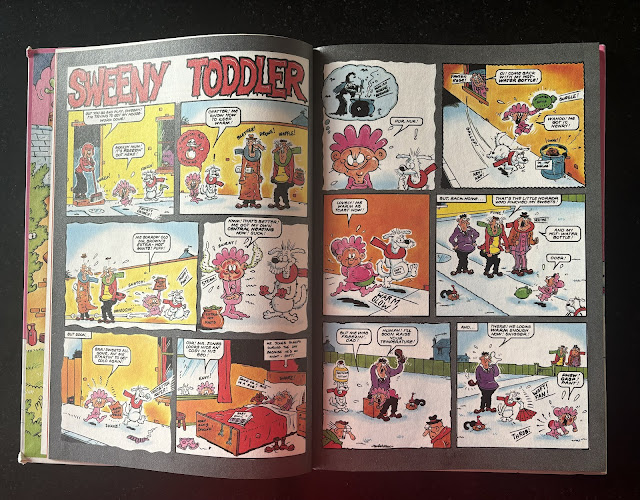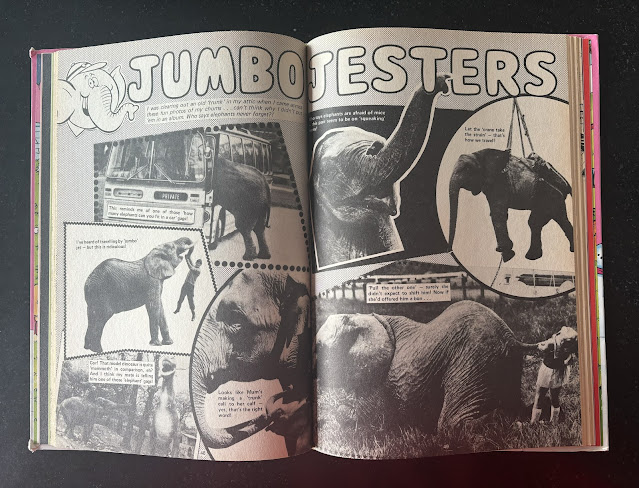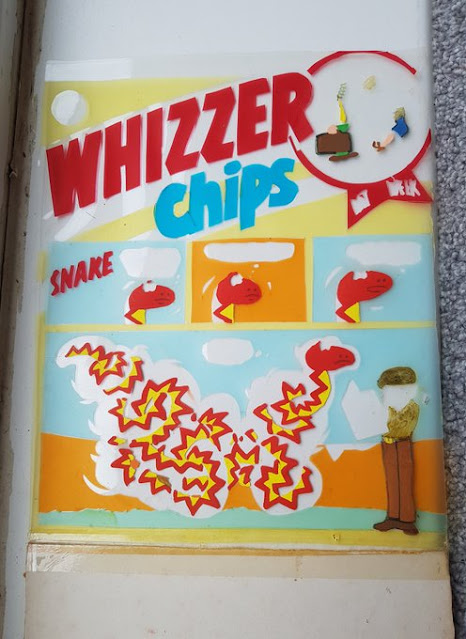Time to take a look at one of the absolute best comics the United Kingdom has ever produced - Smash. When Smash launched back in 1966, top artist Leo Baxendale was already overworked thanks to its sister comic Wham, which he was essentially illustrated cover to cover.
Ok I exaggerate, but despite the workload he still managed to draw the front covers for first three issues of Smash (I shared a few pages from issue three here), all of which promoted the free gifts given away to help get the comic off its feet. Issue one came with a "Big Bang" carboard gun (quite a fun and somewhat common idea for a gift, but more on that here) and issue three had a "Phantom Fighter Jet". To be honest, I'm not quite sure what issue two had. I've pulled the scan of the front cover below from elsewhere and as you can see it says "TOP SECRET", but based on the clues it looks like a hopping cardboard frog. Fun!

Anyway, back on topic. After the gifts ran out, Baxendale pulled out a bright and exciting single panel featuring his character The Man From B.U.N.G.L.E. for issue four. The character is of course a silly parody of spy show The Man From UNCLE. However, he would only ever draw two of these covers for issues four and five, before handing over the reins. Below is the absolutely stunning front cover of issue five, and what Baxendale dubs among his last "official" work for Odhams. More on that in just a moment.
I can only imagine how seeing this front cover on the shelves in 1966 must have felt. As much as I love the Beano and Dandy, covers like these must have made them look dated in comparison. It couldn't be much different to how they made other comics look old fashioned when they hit the shelves in the 30s!
When issue six was published the following week, Baxendale's signature was not to be seen. Instead, I think it was the fabulously talented Ron Spencer who took over the immense task of filling his shoes. And credit where credit is due, he did a fantastic job. Below is the cover of issue six.
"

In his 1978 autobiography A Very Funny Business, Baxendale talks about these few Smash front covers. Rather than reword or summarise, I'll just let him do the talking:
"While I was drawing all these features for Fleetway comics, I was producing a massive amount of 'undercover' work for Odhams. My last 'official' work for Odhams was the Eagle Eye episode in Wham no. 96, for 16 April 1966 (a lovely drawing). Wham's sister comic Smash had started on 6 February 1966. After drawing the first three special 'free gift' front covers for Smash, I created Man from Bungle as the permanent cover feature -- in an attractive big single-picture format. I only drew two of these, before handing over to somebody else. My Grimly Feendish character in Eagle Eye had proved very popular, so he was given a page of his own in Smash. I drew the first nine Grimly Feendish pages very rapidly, using a simplified variation of my normal drawing style. I gave Grimly some daft little subsidiary characters. This was an attractive strip, and was printed in full colour on the back cover of Smash. I also created Bad Penny (A Minnie-the-Minx-type character) as a double-page spread for Smash. These sets (along with the Eagle Eye episode for 16 April) were the last 'official' pages I drew for Odhams.
"I was by now in full spate for Fleetway. But I was reluctant to give up the lucrative Odhams market. Their rates of pay channelled large quantities of pages to Odhams via Mike Brown, a cartoon-film animator. I pencilled and Mike inked them in. One series we did in this manner was the Eagle Eye adventure which ran from 30 July to 7 September 1966. We turned out larger numbers of Grimly Feendish pages and Bad Penny sets in this way."
 |
A Very Funny Business is a must-read for any
fan of British comics. |
So for any young Smash fans who missed Baxendale's work once his stunning front covers ceased, all they had to do was flip over to the back page. Here are the Grimly Feendish strips for issues five and six respectively.
 |
| From Smash #5. |
 |
| From Smash #6. |
And finally, a quick look at Smash number 9. I'll show the front cover too, because Spencer has done a stunning job, but it's the back cover that is of real interest for this post. As Baxendale mentioned in the quote above, he drew nine Grimly Feendish pages "very rapidly". As such, that would make this back page his very last "official" work for Odhams and the wonderful Power comics.









































